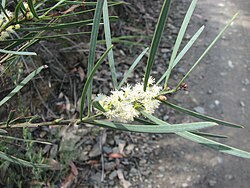Top Qs
Timeline
Chat
Perspective
Acacia suaveolens
Species of plant From Wikipedia, the free encyclopedia
Remove ads
Acacia suaveolens (sweet wattle) is a shrub species endemic to Australia.[2] It grows to between 0.3 and 3.5 metres high and has smooth purplish-brown or light green bark and has straight or slightly curving blue-green phyllodes [3][4] The pale yellow to near white globular flower heads generally appear between April and September in its native range.[3] These are followed by flattened, bluish oblong pods which are up to 2 to 5 cm long and 8 to 19 mm wide.[3][4]
The species was first formally described by English botanist James Edward Smith in 1791 in Transactions of the Linnean Society of London He described it with reference to a cultivated plant at Syon House which had been raised by Thomas Hoy from seed that originated from New South Wales.[1] The species was transferred into the genus Acacia by Carl Ludwig Willdenow in 1806.[1]
The species occurs naturally on sandy soils in heathland and dry sclerophyll forest in South Australia and Victoria, Tasmania, New South Wales and Queensland.[3]
Remove ads
Cultivation
This species provides winter colour in a garden and may be used as a low screen plant.[4]
Gallery
- Acacia suaveolens germinated post bushfire, Wallum heath near Lake Ainsworth, Lennox Head, New South Wales.
- Acacia suaveolens inflorescences, Wallum heath near Lake Ainsworth, Lennox Head, New South Wales.
- Acacia suaveolens inflorescences, Wallum heath near Lake Ainsworth, Lennox Head, New South Wales.
- Acacia suaveolens inflorescences, Wallum heath near Lake Ainsworth, Lennox Head, New South Wales.
Remove ads
References
External links
Wikiwand - on
Seamless Wikipedia browsing. On steroids.
Remove ads






